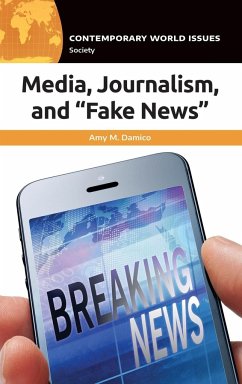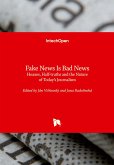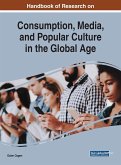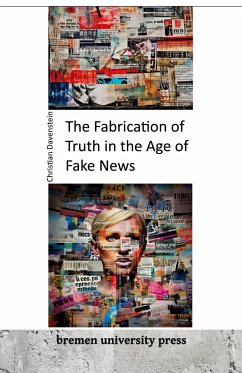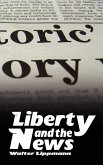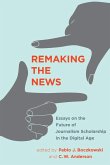- Gebundenes Buch
- Merkliste
- Auf die Merkliste
- Bewerten Bewerten
- Teilen
- Produkt teilen
- Produkterinnerung
- Produkterinnerung
This volume summarizes the evolution of news and information in the United States as it has been shaped by technology (penny press, radio, TV, cable, the internet) and form development (investigative journalism, tabloid TV, talk radio, social media). Media, Journalism, and "Fake News": A Reference Handbook provides readers with an overview of news and media in the United States. Additionally, the book discusses, additionally discussing the economic state of the news industry, partisan news, misinformation and disinformation, issues of representation, and the impact of social media. The volume…mehr
Andere Kunden interessierten sich auch für
![Fake News Is Bad News Fake News Is Bad News]() Fake News Is Bad News129,00 €
Fake News Is Bad News129,00 €![Handbook of Research on Consumption, Media, and Popular Culture in the Global Age Handbook of Research on Consumption, Media, and Popular Culture in the Global Age]() Handbook of Research on Consumption, Media, and Popular Culture in the Global Age295,99 €
Handbook of Research on Consumption, Media, and Popular Culture in the Global Age295,99 €![The Fabrication of Truth in the Age of Fake News The Fabrication of Truth in the Age of Fake News]() Christian DavensteinThe Fabrication of Truth in the Age of Fake News29,90 €
Christian DavensteinThe Fabrication of Truth in the Age of Fake News29,90 €![Liberty and the News Liberty and the News]() Walter LippmannLiberty and the News10,99 €
Walter LippmannLiberty and the News10,99 €![Fake News und Glaubwürdigkeit. Was kann man gegen Fake News tun und wie erkennt man sie? Fake News und Glaubwürdigkeit. Was kann man gegen Fake News tun und wie erkennt man sie?]() Hakan MacitFake News und Glaubwürdigkeit. Was kann man gegen Fake News tun und wie erkennt man sie?17,95 €
Hakan MacitFake News und Glaubwürdigkeit. Was kann man gegen Fake News tun und wie erkennt man sie?17,95 €![New Media Management. Rankingfaktoren und Fake News New Media Management. Rankingfaktoren und Fake News]() AnonymousNew Media Management. Rankingfaktoren und Fake News9,99 €
AnonymousNew Media Management. Rankingfaktoren und Fake News9,99 €![Remaking the News Remaking the News]() Remaking the News35,99 €
Remaking the News35,99 €-
-
-
This volume summarizes the evolution of news and information in the United States as it has been shaped by technology (penny press, radio, TV, cable, the internet) and form development (investigative journalism, tabloid TV, talk radio, social media). Media, Journalism, and "Fake News": A Reference Handbook provides readers with an overview of news and media in the United States. Additionally, the book discusses, additionally discussing the economic state of the news industry, partisan news, misinformation and disinformation, issues of representation, and the impact of social media. The volume starts with a background of the development of news and information in the United States. It then goes on to discuss significant problems, controversies, and solutions related to the topic. Readers also will be able to develop their understanding of the topic by reading profiles of key figures and organizations that contributed to the current news climate. A comprehensive list of resources will help readers decide where to go next should they want to learn more about a particular area of interest.
Hinweis: Dieser Artikel kann nur an eine deutsche Lieferadresse ausgeliefert werden.
Hinweis: Dieser Artikel kann nur an eine deutsche Lieferadresse ausgeliefert werden.
Produktdetails
- Produktdetails
- Verlag: Bloomsbury Publishing plc
- Seitenzahl: 394
- Erscheinungstermin: 25. Oktober 2019
- Englisch
- Abmessung: 235mm x 157mm x 26mm
- Gewicht: 720g
- ISBN-13: 9781440864063
- ISBN-10: 1440864063
- Artikelnr.: 56788730
- Herstellerkennzeichnung
- Libri GmbH
- Europaallee 1
- 36244 Bad Hersfeld
- gpsr@libri.de
- Verlag: Bloomsbury Publishing plc
- Seitenzahl: 394
- Erscheinungstermin: 25. Oktober 2019
- Englisch
- Abmessung: 235mm x 157mm x 26mm
- Gewicht: 720g
- ISBN-13: 9781440864063
- ISBN-10: 1440864063
- Artikelnr.: 56788730
- Herstellerkennzeichnung
- Libri GmbH
- Europaallee 1
- 36244 Bad Hersfeld
- gpsr@libri.de
Amy M. Damico, PhD, is professor of communication at Endicott College. She is coauthor of 21st-Century TV Dramas: Exploring the New Golden Age and coeditor of September 11 in Popular Culture: A Guide.
Preface,
1 Background and History,
Introduction: What Is News?
The Development of the Press and the American Revolution,
Changes in News Reporting,
Shaping Public Opinion,
The Establishment of Professional Journalism,
Investigative Journalism,
Newsmagazines,
Radio News Broadcasting,
Network Television News Programming,
Public Broadcasting,
Talk Radio,
Cable Television and 24-Hour News Networks,
News Satire and "Fake News" Television Shows,
Tabloid Television News,
Media Consolidation,
Digital News and Information,
News Goes Online,
Shifts in News Producers and Audiences,
Conclusion,
Bibliography,
2 Problems, Controversies, and Solutions,
Introduction,
Economic Challenges in the News Industry,
The News Business Model,
News Deserts,
Media Consolidation,
News and Audiences,
News Polarization, Partisanship, and Trust,
News Customization,
News Bias,
Newsroom Diversity,
Challenges to Reliable Information: A Contemporary Exploration of Terms,
The Need for Reliable Information,
"Fake News,"
Misinformation and Disinformation,
Propaganda,
Promotional Information,
Content Fabricated by Journalists,
Conspiracy Theories,
Digital Technologies and News and Information,
News Algorithms,
The Facebook News Feed,
Social Media Bots,
Deepfake Videos,
Solutions,
Organization Initiatives,
Increasing News and Information Literacy,
Searching for New Models of News,
Conclusion,
Bibliography,
3 Perspectives,
Introduction,
The 1970s Newsrooms Balanced Past and Future
Dennis Lein,
From Anonymous Sources to Analytics and Embedded Tweets: The Evolution of
News Sourcing in Modern Journalism
Sean R. Sadri,
Unlocking the Keys to the Brave "News" World: News Literacy as the World's
Most Important Resource
Julie Frechette,
Fake News Is Old News: The Blurry Boundaries between Journalism and Public
Relations
Lori Bindig Yousman,
Western News Media Coverage of Muslims and Arabs: From 9/11 to the Trump
Era
Nahed Eltantawy,
A Plea for Print
Erica Drzewiecki,
Searching for the Source: Bots, Misinformation, and You
Randall Livingstone,
Is Television News Satire the Problem or the Solution?
Bill Yousman,
Alive Day
Kate Felsen,
4 Profiles,
Introduction,
People,
Joseph Pulitzer (1847-1911),
Ida Tarbell (1857-1944),
Adolph Ochs (1858-1935),
William Randolph Hearst (1863-1951),
Rheta Childe Dorr (1866-1948),
Henry Luce (1868-1967),
Dorothy Thompson (1893-1961),
Margaret Bourke-White (1904-1971),
Edward R. Murrow (1908-1965),
Walter Cronkite (1916-2009),
John H. Johnson (1918-2005),
Helen Thomas (1920-2013),
Barbara Walters (1931-),
Carole Simpson (1940-),
Robert (Bob) Woodward (1943-),
Arianna Huffington (1950-),
Oprah Winfrey (1954-),
Amy Goodman (1957-),
Christiane Amanpour (1958-),
Jorge Ramos (1958-),
Ira Glass (1959-),
Nonny de la Peña,
Jodi Rave-Spotted Bear (1964-),
Soledad O'Brien (1966-),
Lisa Ling (1973-),
Ezra Klein (1984-),
Organizations,
CNN (Cable News Network) (1980-),
USA Today (1982-),
The Daily Show (1996-),
Fox News/The Fox News Channel (1996-),
Google News (2002-),
Facebook (2004-),
Twitter (2006-),
Breitbart News Network (2007-),
5 Data and Documents,
Introduction,
Ways Consumers Access News,
Figure 5.1: Percentages of Adults Who Note They Often Get News from These
Sources in 2018,
Figure 5.2: Percentages of Adults Who Obtain News from Popular Social Media
Sites, 2018 versus 2013,
News Deserts,
Table 5.1 State Counts of Counties with No Local Newspaper or Only One
Local Newspaper,
Perceptions of News Media,
Figure 5.3 Trust in News Media,
Figure 5.4 Democrats' Perceptions of the Composition of News Coverage,
Figure 5.5 Republicans' Perceptions of the Composition of News Coverage,
Research on Unreliable Information,
Table 5.2 Examples of "Fake News" Websites,
Table 5.3 Examples of Approaches Some Countries Are Taking to Address
Misinformation Online,
Media Ownership Rules,
Document 5.1 FCC Changes in Broadcast Ownership Rules (2017),
Considering Unreliable Information,
Document 5.2 The Great Moon Hoax (1835),
Document 5.3 Louis Seibold's Fabricated Interview with President Wilson
(1920),
Document 5.4 Call for U.S. Government Disclosure of Video News Release Use
(2005),
Current Discussions of News and Information,
Document 5.5 Overview of Social Media Use by Russian Operatives (2018),
Document 5.6 News Media Alliance's David Chavern's Statement on Technology
Companies and Journalism (2018),
Document 5.7 Judiciary Hearing on Social Media and Content Filtering
Practices (2018),
Addressing "Deepfake" Videos,
Document 5.8 Excerpts of the Malicious Deep Fake Prohibition Act of 2018,
Organizational Initiatives,
Figure 5.6 7 Types of Mis- and Disinformation,
Figure 5.7 Misinformation Matrix,
Document 5.9 Recommendations from the Knight Commission on Trust, Media and
Democracy (2019),
6 Resources,
Introduction,
Books and Articles/Historical Resources,
Books and Articles/Contemporary History and Topics,
Research Organizations and Nonprofits,
Relevant Scholarly Journals,
Additional Web Resources, Videos, and Podcasts,
Tools and Organizations That Help People Develop Skills to Critically
Assess Information,
Popular "Legacy" News Media,
High Circulating Newspapers,
Broadcast/Cablecast News Organizations,
Public News Organizations,
Common News Agencies in the United States,
7 Chronology,
Glossary,
Index,
About the Author,
1 Background and History,
Introduction: What Is News?
The Development of the Press and the American Revolution,
Changes in News Reporting,
Shaping Public Opinion,
The Establishment of Professional Journalism,
Investigative Journalism,
Newsmagazines,
Radio News Broadcasting,
Network Television News Programming,
Public Broadcasting,
Talk Radio,
Cable Television and 24-Hour News Networks,
News Satire and "Fake News" Television Shows,
Tabloid Television News,
Media Consolidation,
Digital News and Information,
News Goes Online,
Shifts in News Producers and Audiences,
Conclusion,
Bibliography,
2 Problems, Controversies, and Solutions,
Introduction,
Economic Challenges in the News Industry,
The News Business Model,
News Deserts,
Media Consolidation,
News and Audiences,
News Polarization, Partisanship, and Trust,
News Customization,
News Bias,
Newsroom Diversity,
Challenges to Reliable Information: A Contemporary Exploration of Terms,
The Need for Reliable Information,
"Fake News,"
Misinformation and Disinformation,
Propaganda,
Promotional Information,
Content Fabricated by Journalists,
Conspiracy Theories,
Digital Technologies and News and Information,
News Algorithms,
The Facebook News Feed,
Social Media Bots,
Deepfake Videos,
Solutions,
Organization Initiatives,
Increasing News and Information Literacy,
Searching for New Models of News,
Conclusion,
Bibliography,
3 Perspectives,
Introduction,
The 1970s Newsrooms Balanced Past and Future
Dennis Lein,
From Anonymous Sources to Analytics and Embedded Tweets: The Evolution of
News Sourcing in Modern Journalism
Sean R. Sadri,
Unlocking the Keys to the Brave "News" World: News Literacy as the World's
Most Important Resource
Julie Frechette,
Fake News Is Old News: The Blurry Boundaries between Journalism and Public
Relations
Lori Bindig Yousman,
Western News Media Coverage of Muslims and Arabs: From 9/11 to the Trump
Era
Nahed Eltantawy,
A Plea for Print
Erica Drzewiecki,
Searching for the Source: Bots, Misinformation, and You
Randall Livingstone,
Is Television News Satire the Problem or the Solution?
Bill Yousman,
Alive Day
Kate Felsen,
4 Profiles,
Introduction,
People,
Joseph Pulitzer (1847-1911),
Ida Tarbell (1857-1944),
Adolph Ochs (1858-1935),
William Randolph Hearst (1863-1951),
Rheta Childe Dorr (1866-1948),
Henry Luce (1868-1967),
Dorothy Thompson (1893-1961),
Margaret Bourke-White (1904-1971),
Edward R. Murrow (1908-1965),
Walter Cronkite (1916-2009),
John H. Johnson (1918-2005),
Helen Thomas (1920-2013),
Barbara Walters (1931-),
Carole Simpson (1940-),
Robert (Bob) Woodward (1943-),
Arianna Huffington (1950-),
Oprah Winfrey (1954-),
Amy Goodman (1957-),
Christiane Amanpour (1958-),
Jorge Ramos (1958-),
Ira Glass (1959-),
Nonny de la Peña,
Jodi Rave-Spotted Bear (1964-),
Soledad O'Brien (1966-),
Lisa Ling (1973-),
Ezra Klein (1984-),
Organizations,
CNN (Cable News Network) (1980-),
USA Today (1982-),
The Daily Show (1996-),
Fox News/The Fox News Channel (1996-),
Google News (2002-),
Facebook (2004-),
Twitter (2006-),
Breitbart News Network (2007-),
5 Data and Documents,
Introduction,
Ways Consumers Access News,
Figure 5.1: Percentages of Adults Who Note They Often Get News from These
Sources in 2018,
Figure 5.2: Percentages of Adults Who Obtain News from Popular Social Media
Sites, 2018 versus 2013,
News Deserts,
Table 5.1 State Counts of Counties with No Local Newspaper or Only One
Local Newspaper,
Perceptions of News Media,
Figure 5.3 Trust in News Media,
Figure 5.4 Democrats' Perceptions of the Composition of News Coverage,
Figure 5.5 Republicans' Perceptions of the Composition of News Coverage,
Research on Unreliable Information,
Table 5.2 Examples of "Fake News" Websites,
Table 5.3 Examples of Approaches Some Countries Are Taking to Address
Misinformation Online,
Media Ownership Rules,
Document 5.1 FCC Changes in Broadcast Ownership Rules (2017),
Considering Unreliable Information,
Document 5.2 The Great Moon Hoax (1835),
Document 5.3 Louis Seibold's Fabricated Interview with President Wilson
(1920),
Document 5.4 Call for U.S. Government Disclosure of Video News Release Use
(2005),
Current Discussions of News and Information,
Document 5.5 Overview of Social Media Use by Russian Operatives (2018),
Document 5.6 News Media Alliance's David Chavern's Statement on Technology
Companies and Journalism (2018),
Document 5.7 Judiciary Hearing on Social Media and Content Filtering
Practices (2018),
Addressing "Deepfake" Videos,
Document 5.8 Excerpts of the Malicious Deep Fake Prohibition Act of 2018,
Organizational Initiatives,
Figure 5.6 7 Types of Mis- and Disinformation,
Figure 5.7 Misinformation Matrix,
Document 5.9 Recommendations from the Knight Commission on Trust, Media and
Democracy (2019),
6 Resources,
Introduction,
Books and Articles/Historical Resources,
Books and Articles/Contemporary History and Topics,
Research Organizations and Nonprofits,
Relevant Scholarly Journals,
Additional Web Resources, Videos, and Podcasts,
Tools and Organizations That Help People Develop Skills to Critically
Assess Information,
Popular "Legacy" News Media,
High Circulating Newspapers,
Broadcast/Cablecast News Organizations,
Public News Organizations,
Common News Agencies in the United States,
7 Chronology,
Glossary,
Index,
About the Author,
Preface,
1 Background and History,
Introduction: What Is News?
The Development of the Press and the American Revolution,
Changes in News Reporting,
Shaping Public Opinion,
The Establishment of Professional Journalism,
Investigative Journalism,
Newsmagazines,
Radio News Broadcasting,
Network Television News Programming,
Public Broadcasting,
Talk Radio,
Cable Television and 24-Hour News Networks,
News Satire and "Fake News" Television Shows,
Tabloid Television News,
Media Consolidation,
Digital News and Information,
News Goes Online,
Shifts in News Producers and Audiences,
Conclusion,
Bibliography,
2 Problems, Controversies, and Solutions,
Introduction,
Economic Challenges in the News Industry,
The News Business Model,
News Deserts,
Media Consolidation,
News and Audiences,
News Polarization, Partisanship, and Trust,
News Customization,
News Bias,
Newsroom Diversity,
Challenges to Reliable Information: A Contemporary Exploration of Terms,
The Need for Reliable Information,
"Fake News,"
Misinformation and Disinformation,
Propaganda,
Promotional Information,
Content Fabricated by Journalists,
Conspiracy Theories,
Digital Technologies and News and Information,
News Algorithms,
The Facebook News Feed,
Social Media Bots,
Deepfake Videos,
Solutions,
Organization Initiatives,
Increasing News and Information Literacy,
Searching for New Models of News,
Conclusion,
Bibliography,
3 Perspectives,
Introduction,
The 1970s Newsrooms Balanced Past and Future
Dennis Lein,
From Anonymous Sources to Analytics and Embedded Tweets: The Evolution of
News Sourcing in Modern Journalism
Sean R. Sadri,
Unlocking the Keys to the Brave "News" World: News Literacy as the World's
Most Important Resource
Julie Frechette,
Fake News Is Old News: The Blurry Boundaries between Journalism and Public
Relations
Lori Bindig Yousman,
Western News Media Coverage of Muslims and Arabs: From 9/11 to the Trump
Era
Nahed Eltantawy,
A Plea for Print
Erica Drzewiecki,
Searching for the Source: Bots, Misinformation, and You
Randall Livingstone,
Is Television News Satire the Problem or the Solution?
Bill Yousman,
Alive Day
Kate Felsen,
4 Profiles,
Introduction,
People,
Joseph Pulitzer (1847-1911),
Ida Tarbell (1857-1944),
Adolph Ochs (1858-1935),
William Randolph Hearst (1863-1951),
Rheta Childe Dorr (1866-1948),
Henry Luce (1868-1967),
Dorothy Thompson (1893-1961),
Margaret Bourke-White (1904-1971),
Edward R. Murrow (1908-1965),
Walter Cronkite (1916-2009),
John H. Johnson (1918-2005),
Helen Thomas (1920-2013),
Barbara Walters (1931-),
Carole Simpson (1940-),
Robert (Bob) Woodward (1943-),
Arianna Huffington (1950-),
Oprah Winfrey (1954-),
Amy Goodman (1957-),
Christiane Amanpour (1958-),
Jorge Ramos (1958-),
Ira Glass (1959-),
Nonny de la Peña,
Jodi Rave-Spotted Bear (1964-),
Soledad O'Brien (1966-),
Lisa Ling (1973-),
Ezra Klein (1984-),
Organizations,
CNN (Cable News Network) (1980-),
USA Today (1982-),
The Daily Show (1996-),
Fox News/The Fox News Channel (1996-),
Google News (2002-),
Facebook (2004-),
Twitter (2006-),
Breitbart News Network (2007-),
5 Data and Documents,
Introduction,
Ways Consumers Access News,
Figure 5.1: Percentages of Adults Who Note They Often Get News from These
Sources in 2018,
Figure 5.2: Percentages of Adults Who Obtain News from Popular Social Media
Sites, 2018 versus 2013,
News Deserts,
Table 5.1 State Counts of Counties with No Local Newspaper or Only One
Local Newspaper,
Perceptions of News Media,
Figure 5.3 Trust in News Media,
Figure 5.4 Democrats' Perceptions of the Composition of News Coverage,
Figure 5.5 Republicans' Perceptions of the Composition of News Coverage,
Research on Unreliable Information,
Table 5.2 Examples of "Fake News" Websites,
Table 5.3 Examples of Approaches Some Countries Are Taking to Address
Misinformation Online,
Media Ownership Rules,
Document 5.1 FCC Changes in Broadcast Ownership Rules (2017),
Considering Unreliable Information,
Document 5.2 The Great Moon Hoax (1835),
Document 5.3 Louis Seibold's Fabricated Interview with President Wilson
(1920),
Document 5.4 Call for U.S. Government Disclosure of Video News Release Use
(2005),
Current Discussions of News and Information,
Document 5.5 Overview of Social Media Use by Russian Operatives (2018),
Document 5.6 News Media Alliance's David Chavern's Statement on Technology
Companies and Journalism (2018),
Document 5.7 Judiciary Hearing on Social Media and Content Filtering
Practices (2018),
Addressing "Deepfake" Videos,
Document 5.8 Excerpts of the Malicious Deep Fake Prohibition Act of 2018,
Organizational Initiatives,
Figure 5.6 7 Types of Mis- and Disinformation,
Figure 5.7 Misinformation Matrix,
Document 5.9 Recommendations from the Knight Commission on Trust, Media and
Democracy (2019),
6 Resources,
Introduction,
Books and Articles/Historical Resources,
Books and Articles/Contemporary History and Topics,
Research Organizations and Nonprofits,
Relevant Scholarly Journals,
Additional Web Resources, Videos, and Podcasts,
Tools and Organizations That Help People Develop Skills to Critically
Assess Information,
Popular "Legacy" News Media,
High Circulating Newspapers,
Broadcast/Cablecast News Organizations,
Public News Organizations,
Common News Agencies in the United States,
7 Chronology,
Glossary,
Index,
About the Author,
1 Background and History,
Introduction: What Is News?
The Development of the Press and the American Revolution,
Changes in News Reporting,
Shaping Public Opinion,
The Establishment of Professional Journalism,
Investigative Journalism,
Newsmagazines,
Radio News Broadcasting,
Network Television News Programming,
Public Broadcasting,
Talk Radio,
Cable Television and 24-Hour News Networks,
News Satire and "Fake News" Television Shows,
Tabloid Television News,
Media Consolidation,
Digital News and Information,
News Goes Online,
Shifts in News Producers and Audiences,
Conclusion,
Bibliography,
2 Problems, Controversies, and Solutions,
Introduction,
Economic Challenges in the News Industry,
The News Business Model,
News Deserts,
Media Consolidation,
News and Audiences,
News Polarization, Partisanship, and Trust,
News Customization,
News Bias,
Newsroom Diversity,
Challenges to Reliable Information: A Contemporary Exploration of Terms,
The Need for Reliable Information,
"Fake News,"
Misinformation and Disinformation,
Propaganda,
Promotional Information,
Content Fabricated by Journalists,
Conspiracy Theories,
Digital Technologies and News and Information,
News Algorithms,
The Facebook News Feed,
Social Media Bots,
Deepfake Videos,
Solutions,
Organization Initiatives,
Increasing News and Information Literacy,
Searching for New Models of News,
Conclusion,
Bibliography,
3 Perspectives,
Introduction,
The 1970s Newsrooms Balanced Past and Future
Dennis Lein,
From Anonymous Sources to Analytics and Embedded Tweets: The Evolution of
News Sourcing in Modern Journalism
Sean R. Sadri,
Unlocking the Keys to the Brave "News" World: News Literacy as the World's
Most Important Resource
Julie Frechette,
Fake News Is Old News: The Blurry Boundaries between Journalism and Public
Relations
Lori Bindig Yousman,
Western News Media Coverage of Muslims and Arabs: From 9/11 to the Trump
Era
Nahed Eltantawy,
A Plea for Print
Erica Drzewiecki,
Searching for the Source: Bots, Misinformation, and You
Randall Livingstone,
Is Television News Satire the Problem or the Solution?
Bill Yousman,
Alive Day
Kate Felsen,
4 Profiles,
Introduction,
People,
Joseph Pulitzer (1847-1911),
Ida Tarbell (1857-1944),
Adolph Ochs (1858-1935),
William Randolph Hearst (1863-1951),
Rheta Childe Dorr (1866-1948),
Henry Luce (1868-1967),
Dorothy Thompson (1893-1961),
Margaret Bourke-White (1904-1971),
Edward R. Murrow (1908-1965),
Walter Cronkite (1916-2009),
John H. Johnson (1918-2005),
Helen Thomas (1920-2013),
Barbara Walters (1931-),
Carole Simpson (1940-),
Robert (Bob) Woodward (1943-),
Arianna Huffington (1950-),
Oprah Winfrey (1954-),
Amy Goodman (1957-),
Christiane Amanpour (1958-),
Jorge Ramos (1958-),
Ira Glass (1959-),
Nonny de la Peña,
Jodi Rave-Spotted Bear (1964-),
Soledad O'Brien (1966-),
Lisa Ling (1973-),
Ezra Klein (1984-),
Organizations,
CNN (Cable News Network) (1980-),
USA Today (1982-),
The Daily Show (1996-),
Fox News/The Fox News Channel (1996-),
Google News (2002-),
Facebook (2004-),
Twitter (2006-),
Breitbart News Network (2007-),
5 Data and Documents,
Introduction,
Ways Consumers Access News,
Figure 5.1: Percentages of Adults Who Note They Often Get News from These
Sources in 2018,
Figure 5.2: Percentages of Adults Who Obtain News from Popular Social Media
Sites, 2018 versus 2013,
News Deserts,
Table 5.1 State Counts of Counties with No Local Newspaper or Only One
Local Newspaper,
Perceptions of News Media,
Figure 5.3 Trust in News Media,
Figure 5.4 Democrats' Perceptions of the Composition of News Coverage,
Figure 5.5 Republicans' Perceptions of the Composition of News Coverage,
Research on Unreliable Information,
Table 5.2 Examples of "Fake News" Websites,
Table 5.3 Examples of Approaches Some Countries Are Taking to Address
Misinformation Online,
Media Ownership Rules,
Document 5.1 FCC Changes in Broadcast Ownership Rules (2017),
Considering Unreliable Information,
Document 5.2 The Great Moon Hoax (1835),
Document 5.3 Louis Seibold's Fabricated Interview with President Wilson
(1920),
Document 5.4 Call for U.S. Government Disclosure of Video News Release Use
(2005),
Current Discussions of News and Information,
Document 5.5 Overview of Social Media Use by Russian Operatives (2018),
Document 5.6 News Media Alliance's David Chavern's Statement on Technology
Companies and Journalism (2018),
Document 5.7 Judiciary Hearing on Social Media and Content Filtering
Practices (2018),
Addressing "Deepfake" Videos,
Document 5.8 Excerpts of the Malicious Deep Fake Prohibition Act of 2018,
Organizational Initiatives,
Figure 5.6 7 Types of Mis- and Disinformation,
Figure 5.7 Misinformation Matrix,
Document 5.9 Recommendations from the Knight Commission on Trust, Media and
Democracy (2019),
6 Resources,
Introduction,
Books and Articles/Historical Resources,
Books and Articles/Contemporary History and Topics,
Research Organizations and Nonprofits,
Relevant Scholarly Journals,
Additional Web Resources, Videos, and Podcasts,
Tools and Organizations That Help People Develop Skills to Critically
Assess Information,
Popular "Legacy" News Media,
High Circulating Newspapers,
Broadcast/Cablecast News Organizations,
Public News Organizations,
Common News Agencies in the United States,
7 Chronology,
Glossary,
Index,
About the Author,

